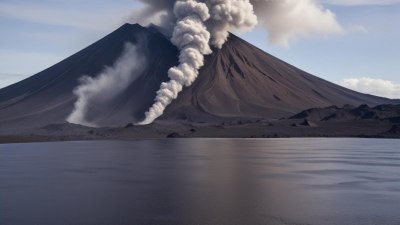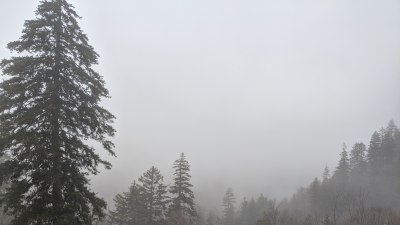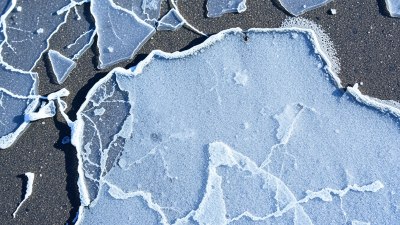How Sound Waves from Volcanoes Affect Weather in Distant Places
Explore the relationship between volcanic sound waves and their impact on distant weather patterns.

This image was created with the assistance of Freepik
Volcanoes are not only a source of spectacular geological activity but also play an important role in the Earth's atmospheric dynamics. The sound waves produced by volcanic eruptions can travel long distances and may have unforeseen implications for weather patterns far from the eruption site. This article delves into the fascinating interplay between volcanic sound waves, atmospheric conditions, and their consequent effects on weather.
The Physics of Sound Waves
To understand how sound waves from volcanoes can influence weather, it is essential to grasp the basic principles of sound propagation. Sound waves are vibrations that travel through various mediums, including air, water, and solids. In the atmosphere, sound waves can travel long distances, particularly when influenced by atmospheric conditions such as temperature, humidity, and wind patterns. The speed of sound can vary depending on these factors, which can significantly impact how volcanic eruptions affect distant weather.
Formation and Types of Volcanic Sounds
Volcanic eruptions generate several types of sounds, primarily due to the explosive release of gases and magma. The most common types of volcanic sounds include:
- Explosive Sounds: Sudden and loud noises generated during explosive eruptions caused by the rapid expansion of gases.
- Hissing and Roaring: Sounds created by escaping gases and lava flow, often experienced during less explosive eruptions.
- Low-Frequency Sounds: These can travel long distances and include infrasound waves, which are sound waves below the frequency of human hearing.
Among these, low-frequency sounds are particularly noteworthy as they can travel thousands of kilometers and may interact with the atmosphere in complex ways.
Interplay Between Volcanoes and Weather
The interaction between volcanic sound waves and the atmosphere can lead to significant meteorological phenomena. Sound waves can stimulate atmospheric turbulence and influence air pressure, temperature, and humidity. Here are a few ways in which volcanic sound waves can impact distant weather:
- Pressure Changes: The energy from volcanic sound waves can create small fluctuations in atmospheric pressure. These pressure changes can interact with existing weather systems, potentially altering their paths and intensities.
- Temperature Effects: Sound waves carrying energy through the atmosphere can affect temperature gradients, which play a crucial role in weather systems. For instance, a sudden influx of thermal energy may lead to localized heating, influencing convection currents and potentially leading to increased storm activity.
- Humidity Variations: The energy emitted from volcanic eruptions can also influence humidity levels in the atmosphere, which can impact cloud formation and precipitation patterns.
Case Studies of Volcanic Eruptions Impacting Weather
There are several documented instances where volcanic eruptions and their associated sound waves were linked to changes in weather patterns.
- Mount St. Helens (1980): The eruption of Mount St. Helens was accompanied by loud explosions and emitted low-frequency sounds that traveled across the United States. Following the eruption, there were unusual weather phenomena observed, including changes in rainfall patterns in states far away from the eruption site.
- Krakatoa (1883): The eruption of Krakatoa is one of the most significant historical precedents regarding volcanic sound waves and weather. The explosion generated immense sound waves that circled the globe multiple times. Subsequent atmospheric changes resulted in dramatic climate anomalies, including unusual temperature drops and increased rainfall over various regions in the following years.
- Eyjafjallajökull (2010): The eruption of Eyjafjallajökull in Iceland produced significant ash clouds and sound waves that had far-reaching effects. The interaction of the eruption with prevailing wind patterns altered temperature and precipitation in parts of Europe, affecting weather patterns for months.
The Role of Infrasound in Weather Influence
Infrasound, which refers to sound waves below the threshold of human hearing, produced by volcanoes can be a critical factor in weather patterns. Infrasound travels long distances and interacts with the atmosphere in unique ways:
- Detection and Monitoring: Infrasound waves can be detected using specialized equipment, providing valuable data for scientists. By monitoring infrasound from volcanic eruptions, researchers can predict how these sound waves may influence local and distant weather patterns.
- Atmospheric Wave Interactions: Infrasound can generate atmospheric waves that propagate through the stratosphere and troposphere. These waves can lead to turbulence and affect the stability of the atmosphere, ultimately influencing weather systems.
The Global Climate Impact of Volcanic Eruptions
Not only do volcanic eruptions affect regional climates, but they can also lead to global climatic changes. This occurs largely due to the release of volcanic gases such as sulfur dioxide (SO2) and ash into the atmosphere:
- Stratospheric Aerosols: When volcanoes erupt, they emit a significant amount of ash and gases that can travel into the stratosphere. These aerosols can reflect sunlight, leading to temporary cooling effects on the Earth's surface. This phenomenon can alter weather patterns on a global scale.
- Disruption of Jet Streams: The presence of aerosols in the upper atmosphere can affect jet streams, which are crucial players in determining weather systems. Changes in jet stream patterns can lead to increased frequency and intensity of storms in some areas while causing droughts in others.
Future Research Directions
The intricate relationship between volcanic sound waves and weather systems requires further investigation to understand their full implications. Future research should focus on:
- Advanced Monitoring Techniques: Developing and implementing better monitoring systems capable of detecting infrasound and acoustic emissions from volcanoes in real-time to provide early warning signals for potentially impacted weather systems.
- Modeling Atmospheric Interactions: Creating models that simulate the interaction between volcanic sound waves and atmospheric conditions to predict how eruptions may affect local and global weather patterns.
- Collaboration Across Disciplines: Encouraging collaboration between volcanologists, atmospheric scientists, and meteorologists to develop a comprehensive understanding of how volcanic eruptions influence weather.
In conclusion, the sound waves generated by volcanic eruptions are not merely the echoes of geological activity but have profound implications for weather systems across the globe. The interplay of sound waves with atmospheric dynamics can initiate complex changes in temperature, pressure, and humidity. Understanding this relationship is crucial for predicting weather anomalies and mitigating the impacts of future volcanic eruptions. As climatic changes continue to pose challenges for society, recognizing the interconnectedness of geological and atmospheric phenomena will be essential for developing adaptive strategies.











